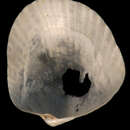pt-BR
nomes no trilho de navegação


“Lyonsiella radiata Dall
Plate VIII, Fig. 7.
Lyonsiella radiata Dall, Bull. Mus. Comp. Zoöl., XVIII, p. 442, June, 1889.
Shell large, thin, pearly, recalling L. gemma Verrill (= insculpta Jeffr. + ecostata Seguenza), but very much larger, higher, less rounded anteriorly, less pointed behind, and more produced and rounded ventrally; hinge simple, undulated, with a rather large, arched ossicle; exterior whitish, with a thin olivaceous epidermis raised over five ribs into rather high distant radiating ridges, to which mud adheres tenaciously; incremental lines distinct, silky, sometimes prominent; lunule in the right valve impressed, produced laterally, not marginated; interior pearly, with faint radiating sulci, corresponding to the external ridges; maximum altitude of shell, 13; longitude, 11; diameter, 8.5mm.
HAB. – In Magellan Straits, at U.S. Fish Commission Station 2780, in 369 fathoms, mud; and at Station 2785, off the west coast of Patagonia, south latitude 48°9’, in 449 fathoms, mud; temperatures 46°.9 F. in both cases.
There are a large number of acephalous mollusks, not necessarily nearly related, in which a true branchial septum exists. In a young Perna, supposed to be P. ephippium L., the inner edges of the ctenidia are united to each other their whole length behind the foot. The outer edges are attached to the mantle, or visceral epiderm, so as to form a complete chamber, like that of Cuspidaria, but of which the derivation is radically different. In Modiolarca trapesina Lam., from Cape Horn, the ctenidia, from below the anal siphonal orifice to and around the foot, are united as in Perna. The chamber thus constituted is crammed with the young fry at the proper season. In Lyonsia beana Orb. the united ctenidia are attached above the rudimentary siphonal septum, extend forward to and around the foot. They are attached to each other and to the mantle, or to the ventral surface of the visceral mass, by their edges and form a most complete chamber, a true ctenidial septum. There are, however, no orifices in this or in any of the species with a strictly ctenidial septum corresponding to the septal perforations in Poromya or Cuspidaria.
In Lyonsia radiata we have a similar state of affairs, except that the anterior inner edges of the gill are not so closely united around the foot. The part played by the siphonal septum in this species is insignificant; it is in fact hardly perceptible. The infolding of the mantel edge around the siphon is very wide; its outer edge is nearly plain. Within this edge a short distance is an elevated ridge, with a single row of small, rounded, ocellus-like tubercles on each side of it. A wide space separates this range of processes from the margin of the branchial orifice, which is profusely papillose with arborescent papillæ. A lunate depression lies between this and the much smaller, plain-edged, nearly linear anal orifice, while in front of it the pedal opening forms a minute narrow slit, with granulated margin. In this form the palps are represented by a slightly raised edge around the mouth, not produced or elongated at the sides. A languette or curtain valve hangs behind the branchial orifice below the narrow septum.
The balance of characters will perhaps carry Mytilimeria and Lyonsiella to the Anatinidæ, or a family by themselves, rather than to the Verticordiidæ, where I first placed them. But they are transitional in their relations, and in spite of the relations between the form of the gills in Lyonsiella and Lyonsia, I am still inclined to think the former almost equally close to Verticordia. A supposed discrepancy, noted by Pelseneer, arises from the fact that, instead of comparing Lyonsiella with a genuine Verticordia, like acuticostata, as I did, he compares it with a species of Poromys, which is, of course, a very different thing.”
(Dall, 1889)
Policordia radiata is een tweekleppigensoort uit de familie van de Lyonsiellidae.[1] De wetenschappelijke naam van de soort is voor het eerst geldig gepubliceerd in 1889 door Dall.
Bronnen, noten en/of referenties